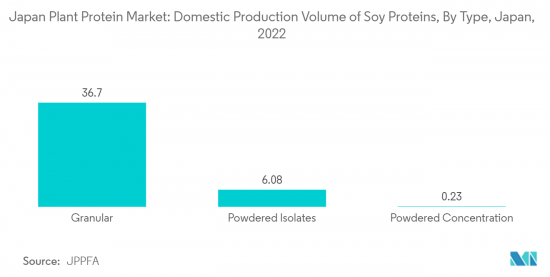Need help finding what you are looking for?
Contact Us
PUBLISHER: Mordor Intelligence | PRODUCT CODE: 1406971

PUBLISHER: Mordor Intelligence | PRODUCT CODE: 1406971
Japan Plant Protein - Market Share Analysis, Industry Trends & Statistics, Growth Forecasts 2024 - 2029
PUBLISHED:
PAGES: 80 Pages
DELIVERY TIME: 2-3 business days
SELECT AN OPTION

The Japan plant protein market size is expected to grow from USD 299.58 million in 2024 at a CAGR of 2.28% over the upcoming years.
Key Highlights
- The Japan plant protein market has witnessed substantial growth in recent years, largely driven by changing consumer preferences towards sustainable and plant-based diets. As awareness of environmental and health concerns continues to rise, many Japanese consumers are seeking alternatives to animal-based proteins, making plant proteins increasingly popular. Japan's younger generations are more sustainability-minded and interested in new food trends. Companies need to appeal to them with affordable and tasty offerings to ensure that alt proteins become a staple part of their diets in the future.
- On the other end of Japan's aging population, the silver generation market is huge. For instance, according to the Ministry of Internal Affairs and Communications (Japan), in November 2022, close to 36.5 million people in Japan were estimated to be within the age group of 65 and over. Animal proteins are difficult to digest for seniors, so plant-based proteins have an opportunity to become popular in this market.
- Furthermore, Japan has established Government bodies to promote food technology, including alternative proteins. In 2021, the government released a white paper that listed substitute meats as a solution to helping Japan reach 2050 targets for net-zero emissions because they release fewer greenhouse gasses during their production than meat. Economic institutions like the Japan External Trade Organization are also working to collaborate with alt protein companies inside and outside of Japan to help grow the market. Also, in 2022, the domestic production volume of wheat proteins in Japan amounted to around 5.7 thousand tons, according to the Japan Plant Protein Food Association (JPPFA). Wheat gluten processed in Japan includes mainly granular, powdered, and paste-like products. They can be used in the production of mock meat but are most commonly found as steamed or baked dough blocks in Japanese cuisine.
Japan Plant Protein Market Trends
Soy Protein Held the largest Market Share
- Soybeans have been a traditional staple of the Japanese diet for centuries, making soy-based products culturally accepted and familiar to the population. This longstanding familiarity provides a natural foundation for the adoption of soy protein-based foods and beverages. Furthermore, soy protein boasts an impressive nutritional profile. It is a complete protein containing all nine essential amino acids required by the human body.
- Additionally, it is low in saturated fat, cholesterol-free, and a good source of vitamins, minerals, and dietary fiber. As a result, soy protein appeals to health-conscious consumers looking for nutritious and balanced plant-based alternatives. The popularity of soy protein in Japan is also reinforced by the growing number of individuals with specific dietary preferences or restrictions.
- Vegans, vegetarians, and those with lactose intolerance often turn to soy-based products as a viable source of protein and other essential nutrients. This expanding consumer base further drives the demand for soy protein products in the market. For instance, according to the JPPFA, In 2022, the domestic production volume of powdered concentration of soy proteins in Japan amounted to around 231 tons.
- Moreover, the Japanese government's efforts to promote a healthy and sustainable diet have contributed to the rise of plant-based proteins, including soy protein. Initiatives supporting research and development in the plant protein sector and the inclusion of plant-based foods in public institutions have encouraged both consumers and businesses to embrace soy protein as a viable and eco-friendly option.
Consumer Inclination Toward Protein-rich Food
Japan Plant Protein Industry Overview
Additional Benefits:
Product Code: 90206
TABLE OF CONTENTS
1 INTRODUCTION
- 1.1 Study Assumptions & Market Definition
- 1.2 Scope of the Study
2 RESEARCH METHODOLOGY
3 EXECUTIVE SUMMARY
4 MARKET DYNAMICS
- 4.1 Drivers
- 4.1.1 Consumer Inclination Toward Protein-rich Food
- 4.1.2 Growing Inclination Towards Plant-based Protein Sources
- 4.2 Restraints
5 Market Segmentation
6 Competitive Landscape
7 MARKET OPPORTUNITIES AND FUTURE TRENDS
Have a question?


SELECT AN OPTION
Have a question?


Questions? Please give us a call or visit the contact form.

